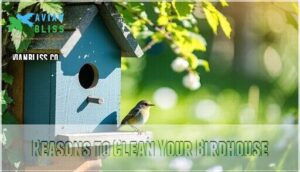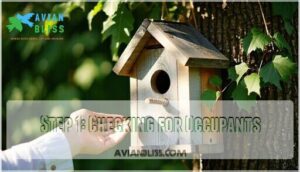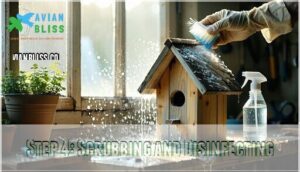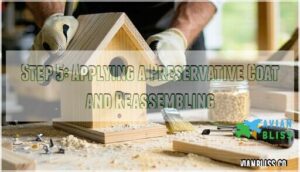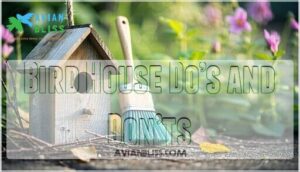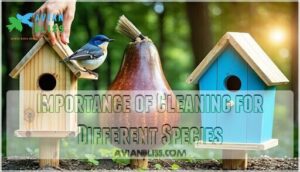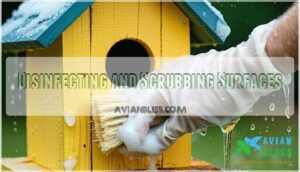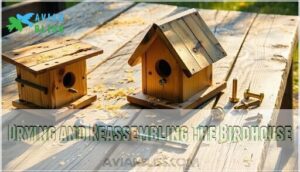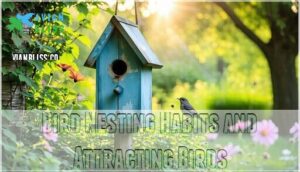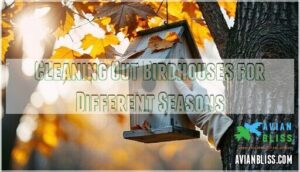This site is supported by our readers. We may earn a commission, at no cost to you, if you purchase through links.
 Cleaning your birdhouse keeps it cozy and safe for your feathered friends. Start by checking that no birds are still inside—nobody likes an unexpected house eviction!
Cleaning your birdhouse keeps it cozy and safe for your feathered friends. Start by checking that no birds are still inside—nobody likes an unexpected house eviction!
Remove old nesting material and scrub the interior with a stiff brush. A 10% bleach solution (9 parts water, 1 part bleach) works wonders for disinfecting, but don’t skip rinsing it thoroughly.
Let it dry completely to avoid mold. While you’re at it, inspect for cracks or loose parts, and make sure drainage and ventilation holes are clear.
A well-maintained birdhouse isn’t just for show—it’s the VIP suite of the bird world! Who’s moving in next? It’s a cozy place for birds, and with proper maintenance, it will remain a safe haven, providing a safe environment for them.
Table Of Contents
- Key Takeaways
- Reasons to Clean Your Birdhouse
- When to Clean Your Birdhouse
- How to Care for Your Birdhouse
- Bird House Do’s and Don’ts
- Importance of Cleaning for Different Species
- How to Clean a Birdhouse Efficiently
- Bird Nesting Habits and Attracting Birds
- Bird House Maintenance and Design
- Cleaning Out Birdhouses for Different Seasons
- Tips for a Safe and Healthy Birdhouse
- Frequently Asked Questions (FAQs)
- Should you clean your Birdhouse?
- How do you sanitize a birdhouse?
- When is the best time to clean a birdhouse?
- How often should a bird house be cleaned out?
- How do you clean a birdhouse with bleach?
- How do you maintain a birdhouse during the nesting season?
- Do birds care if a birdhouse is painted?
- Should you keep your Birdhouse clean?
- How do you clean a bird house?
- How can you prevent pests in birdhouses?
- Conclusion
Key Takeaways
- Clean your birdhouse at least twice a year, ideally in early spring and fall, to prevent bacteria, pests, and old nesting debris.
- Use a safe cleaning solution like a 1:9 bleach and water mix, scrub thoroughly, rinse well, and let it dry completely in sunlight.
- Always check for birds or active nests before cleaning, and ensure ventilation holes and drainage are clear.
- Add predator guards and maintain the birdhouse structure by repairing damages and using weather-resistant materials for long-term use.
Reasons to Clean Your Birdhouse
Cleaning your birdhouse keeps it safe for feathered visitors by removing harmful bacteria, mites, and old nests.
A clean birdhouse means happy birds, free from pests and ready to nest safely year after year!
Plus, a fresh, tidy space makes birds more likely to return, giving you more chances to enjoy their cheerful company!
Avoiding Predators and Unwanted Visitors
Prevent unwanted guests in your birdhouse with these tips!
- Install predator guards to block entry from predators like snakes and squirrels.
- Keep the entrance size small, ideal for the nesting species but tough for invaders.
- Place your birdhouse wisely—on poles, high up, and away from trees to deter climbers.
Regular cleaning and smart placement guarantee birdhouse safety!
Attracting Birds and Encouraging Nesting
A spotless birdhouse is like a cozy Airbnb for birds—they’ll flock to it!
A clean birdhouse is a VIP suite for birds—where they chirp, nest, and thrive in ultimate comfort!
To keep new tenants happy, follow these tips:
- Birdhouse Placement: Install it in shaded, predator-free spots.
- Nesting Materials: Offer dry grass or cotton nearby to suit species preferences.
- Habitat Enhancement: Add feeders and a water source to create an inviting space.
- Bird Hygiene Tips: Regular birdhouse cleaning guarantees it’s pest-free and ready for nesting birds.
Happy birds, happy home!
When to Clean Your Birdhouse
You should clean your birdhouse at least once a year, ideally after nesting season ends in early fall.
Between broods, a quick cleanup can also keep things fresh and inviting for your feathered tenants.
Cleaning Schedule and Practices
Keeping your birdhouse tidy is like managing a cozy Airbnb for your feathered friends! Follow this simple birdhouse cleaning schedule:
- Frequency guidelines: Clean at the start and end of the breeding season, with a light wipe between broods.
- Seasonal timing: Check local nesting intervals to suit regional variations.
- Cleaning intervals: Avoid letting old nests linger too long—they invite mites.
Here’s a quick cheat sheet:
| Task | Timing | Why It Matters |
|---|---|---|
| Deep cleaning | Early spring | Prepare for nesting season. |
| Light wiping | Between broods | Guarantee health and hygiene. |
| Seasonal cleaning | End-of-season | Remove parasites or debris. |
| Visual inspection | Monthly | Spot wear/damage early. |
| Maintenance tweaks | As needed | Keep it bird-ready year-round! |
Cleaning After Breeding Season
After the breeding season wraps up, it’s the perfect moment for a proper post-breeding cleaning. Birds may have moved on, but pests and bacteria could be sticking around. A healthy birdhouse starts with nest removal and some TLC.
Here’s your quick checklist:
- **Toss out old nests.
** Birds don’t reuse them, so clearing them keeps things fresh.
- **Tackle bird house parasites.
** Use a disinfecting solution (1 part bleach to 9 parts water).
- **Grab the right tools.
** Gloves, scrub brushes, and a toothbrush work wonders.
- **Focus on timing importance.
** Clean now so second broods get a clean, safe start!
Cleaning Between Broods
Once one brood has flown, don’t let your birdhouse turn into a pest motel!
Swift birdhouse cleaning between broods helps with parasite control and encourages second nesting.
Remove old nesting materials and debris to support fledgling success.
Fresh, clean nesting boxes give new families a safe, inviting space while keeping harmful mites and germs away.
Clean bird houses, happy birds, with a focus on parasite control!
How to Care for Your Birdhouse
Caring for your birdhouse keeps it safe, clean, and ready for feathered visitors.
With just a little effort, you can create a cozy and healthy space that birds will love to call home.
Step 1: Checking for Occupants
Before diving into birdhouse cleaning, start with an active nest check.
Peek through the entrance hole to spot signs of birdhouse tenants like feathers or nesting materials.
Listen closely for chirps indicating active nesting or identifying nestlings.
Consider the optimal height for placement to deter predators.
If it’s silent and seems abandoned, proceed carefully to confirm the nest’s empty.
This avoids disturbing species mid-cycle—nobody likes their home ransacked!
Step 2: Disassembling The Birdhouse
Before birdhouse disassembly, grab your tools and embrace patience! Check the structure’s integrity and note how it’s assembled for easy reassembly.
Different fastener types might need a screwdriver, pliers, or even a hammer.
- Screwdriver: Essential for fasteners.
- Hammer: For stubborn nails.
- Gloves: Protect those hands!
- Bucket: Catch loose debris.
- Notebook: Jot disassembly notes.
Step 3: Emptying and Cleaning The Birdhouse
Ready to get started? Grab gloves and start removing old nests—it’s like spring cleaning but for birds!
Scoop out debris, bag it, or compost it safely. Check for pests or damage while you’re at it.
Here’s a quick reference:
| Task | Tool Selection | Safety Measures |
|---|---|---|
| Nest Removal | Gloves, Trash Bag | Prevent bacteria spread |
| Debris Disposal | Hand Scoop | Wear a mask for dust |
| Initial Inspection | Flashlight | Avoid sharp edges |
Done? High five! Moving on to the next task with a sense of accomplishment after completing the initial inspection.
Step 4: Scrubbing and Disinfecting
Grab your gloves and mix a safe cleaning solution—nine parts water, one part bleach.
Use scrubbing techniques that target every crevice to banish grime and hidden bacteria. Rinse thoroughly, making sure no bleach solution lingers.
For an alternative, consider using a specialized cleaning product.
Don’t rush—proper drying methods like air-drying in sunlight are key to disinfecting bird houses. A hygienic birdhouse keeps your feathered friends happy and healthy, ensuring a healthy environment.
Step 5: Applying a Preservative Coat and Reassembling
After cleaning, protect your birdhouse with a quality preservative for added weatherproofing and longevity. Linseed oil is a great choice for many birdhouse materials, but make certain of proper coat thickness for durability.
- Apply evenly, focusing on edges to prevent cracking.
- Inspect hardware, tightening screws and replacing damaged parts.
- Let it fully dry before reassembly to avoid stickiness.
- Check for and fix sharp edges or cracks.
- Make certain ventilation holes are clear for bird comfort.
Bird House Do’s and Don’ts
Cleaning your birdhouse the right way keeps it safe and inviting, but a few missteps can cause more harm than good.
Stick to the basics—regular upkeep and safe cleaning practices make all the difference for your feathered friends.
Do: Regular Cleaning and Maintenance
A little effort goes a long way with birdhouse maintenance. Regular cleaning isn’t just about appearances—it’s about hygiene benefits, preventing decay, and encouraging returns.
Stick to a cleaning frequency that feels manageable, like after birds move out. It extends lifespan and keeps things inviting.
Frequency matters: scrub off debris, rinse thoroughly, and your feathered friends will treat it like home sweet home! To prevent pests, it’s recommended to remove old materials.
Don’t: Using Harsh Chemicals or Damaging The Birdhouse
Stick to safe cleaning solutions like a natural birdhouse cleaner or a mild bleach solution (1:9 ratio).
Harsh chemicals and scented cleaners harm birds and weaken the wood. Avoid abrasive cleaning that scratches surfaces, ruining the structural integrity.
Gentle scrubbing and proper disinfecting techniques keep birdhouses cozy and safe. Treat the birdhouse like fine furniture—no bird wants a damaged, smelly home!
Importance of Cleaning for Different Species
Cleaning your birdhouse isn’t a one-size-fits-all job, since different species have unique needs and nesting habits.
By tailoring your cleaning routine to match their preferences, you’ll keep them happy, healthy, and ready to move in year after year, which is crucial for maintaining a healthy environment.
Bluebirds and Their Nesting Habits
Keeping your bluebird nest box spotless isn’t just housekeeping—it’s life-saving for these cheery, insect-eating friends. Bluebirds love a clean, cozy spot to lay their eggs, and regular birdhouse cleaning guarantees their families grow safely in a pest-free environment.
Plus, birdhouse cleaning helps with bluebird conservation by protecting these bright bundles of joy from diseases and predators. You’ll also attract more bluebirds to your yard when their habitat matches their picky preferences.
- Remove old nests to eliminate mites and bacteria.
- Use non-toxic cleaning solutions for safer bluebird nesting behavior.
- Dry thoroughly, guaranteeing their bluebird habitat preferences are met.
Wrens and Their Nesting Preferences
Wrens bring charm and liveliness to your yard, but they’re picky nesters. Getting the wren house size right and maintaining clean birdhouses is a must. Wrens prefer tight spaces with specific wren entry holes and a new, tidy start each season.
Removing old nesting material preferences keeps their homes healthy. Curious about wren species differences? Some wrens cram nests full of twigs!
| Tip | Why It Matters |
|---|---|
| Match wren hole size | Keeps out predators |
| Remove old nests | Reduces parasites |
| Use natural cavities | Appeals to wrens’ habits |
| Clean between broods | Attracts nesting birds |
| Check for damages | Guarantees safety |
Make your yard irresistible for happy, nesting wrens!
Chickadees and Their Nesting Requirements
Chickadees are picky tenants, preferring birdhouses with the right cavity size and entrance size for safety.
Regular bird house cleaning keeps things fresh and keeps pests at bay. After nesting birds fly off, clear out old nesting materials.
Location matters, too—place birdhouses in quiet, shady spots to attract this charming bird species and make them feel at home.
Woodpeckers and Their Nesting Needs
Woodpeckers are picky about their homes, preferring specific cavity sizes and materials.
Regular birdhouse cleaning prevents pests and keeps things cozy for your feathered friends. Dust and debris? No, thanks! A clean birdhouse means safer nesting.
- Clean between seasons to avoid pests.
- Use wood-friendly designs to attract woodpeckers.
- Inspect regularly for damage.
- Rinse thoroughly after scrubbing.
- Add predator guards for nest protection.
How to Clean a Birdhouse Efficiently
Cleaning a birdhouse isn’t as tricky as it sounds, and a few simple steps can make a big difference.
With the right tools and a little effort, you’ll create a safe, welcoming space for your feathered visitors.
Removing Nests and Debris
Got a birdhouse that needs some TLC? Start with bird nest removal! Clearing out old debris isn’t just helpful; it’s a must-do for keeping your feathered friends healthy.
- Slip on gloves for safe handling practices—mites aren’t something you want to bring home.
- Carefully scoop out old nests, bagging them up for proper nest material disposal—composting works too!
- Use tweezers or tongs as handy debris removal tools for those pesky, stubborn nest removal moments.
- Toss or clean any leftover bits to avoid preventing re-infestation.
For efficient cleanup, consider using specialized nest disposal products. Cleaning birdhouses keeps them fresh and ready for new tenants!
Disinfecting and Scrubbing Surfaces
After clearing out nests, it’s time to tackle germs! Mix a safe bleach solution (1 part bleach, 9 parts water) and grab your scrubbing tools.
Focus on cracks and crevices using thorough scrubbing techniques to remove grime and bacteria. Wear gloves to stay safe.
Rinse thoroughly with clean water—it’s like giving your birdhouse a rejuvenating spa day! Clean birdhouses = happy birds!
Drying and Reassembling The Birdhouse
Once rinsing is done, let the birdhouse sun dry completely—avoid any leftover moisture that could attract mold.
Check the hardware for loose screws or jagged edges.
Follow the proper reassembly order, ensuring openings and ventilation are clear. Secure everything tightly.
Think of it like putting a puzzle back together—except this one houses cheerful chirpers, not pieces!
Bird Nesting Habits and Attracting Birds
When you understand how birds choose their nesting spots, you can make your birdhouse irresistible.
It’s all about creating a cozy, safe space they’ll want to call home, like offering a bird-sized dream house!
Understanding Bird Behavior and Nesting Patterns
Understanding bird nesting behaviors helps you take better care of your feathered neighbors.
Birds carefully pick nesting sites and Nesting Material Preferences to protect their Brood Size while juggling Territory Defense and Fledgling Behavior.
Observing Migration Patterns and cleaning your birdhouse between families guarantees you’re ready for the next tenants.
Smart nesting box cleaning equals happy birds and a thriving backyard habitat!
Creating an Attractive Bird-Friendly Environment
Creating a bird-friendly haven isn’t rocket science—it’s about thoughtful touches. Start with sturdy birdhouses using safe materials, placed at proper heights with good ventilation. Add native plants for shelter and food. Place water sources nearby for a rejuvenating splash. Finally, outsmart predators with clever deterrents, keeping nests safe.
Monogamous relationships are common in many species. A welcoming yard draws chirpy visitors effortlessly!
- Native plants: Offer food and nesting cover.
- Water source: Set up birdbaths or fountains.
- Birdhouse placement: Choose shaded spots with good ventilation.
- Predator deterrents: Use baffles or protective guards.
- Cleaning bird houses: Regular scrubbing guarantees hygiene.
Choosing The Right Birdhouse Design
The perfect birdhouse design starts with getting the birdhouse dimensions and entry hole size just right for your feathered friends.
Opt for untreated wood to guarantee material durability, and don’t forget proper birdhouse ventilation and drainage to keep things cozy.
Use predator guards for safety and consider the best mounting options and birdhouse placement—shield it from predators and bad weather.
A well-designed birdhouse is like rolling out the red carpet for birds!
Bird House Maintenance and Design
Keeping your birdhouse in great shape doesn’t just help the birds—it makes your yard a hotspot for happy, healthy visitors.
From picking sturdy materials to installing it just right, a little effort goes a long way in giving your feathered friends a safe, cozy home.
Building Your Own Birdhouse
Building a birdhouse is like creating a snug retreat for feathered friends.
Start with DIY Birdhouse Plans suited to your favorite birds. Focus on birdhouse dimensions that fit your species, add proper ventilation and drainage, and include a cleanout door for easy maintenance. Consider using pre-made birdhouse plans for inspiration.
Follow this simple checklist:
- Choose weatherproof materials.
- Use non-toxic paints or stains.
- Include predator-proof entry holes.
- Position it securely with ideal birdhouse placement.
- Customize a sleek look they’ll love—because every bird deserves a home upgrade!
Choosing The Right Materials and Designs
For a high-quality birdhouse, go for weather-resistant wood types like cedar or pine.
Size matters—pick dimensions matching your birds’ needs. A snug entry hole keeps predators out, while solid birdhouse drainage and ventilation prevent messes and mildew.
Add sloped roofs for easy birdhouse repairs and cleaning. Smart birdhouse design isn’t tough—it’s the key to making birds feel right at home!
Installing and Maintaining Your Birdhouse
When installing your birdhouse, location selection is key—mount it on a sturdy pole instead of trees to stop squirrels or crows from turning it into a buffet.
Add predator guards for extra safety.
Weather protection and material durability guarantee your birdhouse weathers the seasons.
Make maintenance stress-free with features like a cleanout door for easy birdhouse cleaning between seasons.
Regular birdhouse repairs, including checking drainage holes and tightening screws, keep it in top shape to create a safe space for feathered friends.
These simple birdhouse cleaning tips create an inviting space for feathered friends!
Cleaning Out Birdhouses for Different Seasons
Keeping your birdhouses clean throughout the seasons isn’t just helpful—it’s essential.
By adjusting your cleaning routine to match the time of year, you’ll keep birds safe, healthy, and coming back for more.
Spring and Summer Cleaning
Spring’s here—time for some birdhouse TLC! After each brood, cleaning bird houses is Post-Nesting Cleaning 101. During these warmer months, spruce up their homes to keep birds happy, safe, and parasite-free.
Strap on gloves, grab mild soap (skip the scented stuff), and rinse thoroughly.
- Spring Cleaning Birds: Clean after every nesting.
- Seasonal Maintenance: Repair damage during inspections.
- Fledgling Safety: Check for sharp edges.
- Parasite Prevention: Keep it spotless!
Clean, rinse, dry, repeat—it’s that simple!
Fall and Winter Cleaning
Fall birdhouse cleaning is vital to prepare for winter roosting and keep birds cozy during colder months. Start by removing old nesting material and debris—nobody likes last season’s leftovers! Use gloves, a scoop, and mild soap with a soft brush for gentle cleaning. Skip harsh chemicals; birds have sensitive noses!
Here’s your checklist:
| Task | Tools | Frequency |
|---|---|---|
| Remove old nests | Gloves, small scoop | After each brood/fall |
Fall preparation keeps birdhouses from suffering seasonal damage. Reposition near bushes or trees if needed. Winter bird house prep guarantees your feathered friends have a snug, safe spot!
Deep Cleaning and Maintenance
A deep clean keeps your birdhouse welcoming!
Thorough scrubbing with a bleach solution (1:9) helps fight bacteria.
Follow these steps:
- Empty old debris.
- Scrub inside/out with disinfecting solutions.
- Inspect for damage—fix cracks or loose parts.
- Clear clogged ventilation holes to prevent mold.
- Let it air dry completely.
Good cleaning prevents material degradation and guarantees structural integrity! It is crucial for maintaining a clean environment for the birds.
Tips for a Safe and Healthy Birdhouse
Keeping your birdhouse clean and well-maintained isn’t just good housekeeping—it’s a lifesaver for your feathered guests.
A little effort keeps harmful pests and bacteria out, making it a cozy, safe spot for nesting birds.
Reducing The Risk of Predators and Pests
Protecting birds from predators and pests starts with smart planning.
Location matters—mount birdhouses on poles, away from trees where sneaky critters can climb.
Add predator guards to block access, and pick birdhouse designs with small entry holes.
Regular birdhouse cleaning and pest prevention keep birdhouse mites and ectoparasites at bay.
Stay vigilant by monitoring nests often—you’re like their personal security team!
Creating a Healthy Environment for Birds
A well-maintained birdhouse can be a lifesaver for avian health! Cleaning prevents parasites while promoting hygiene and disease prevention.
Use safe materials and provide proper ventilation to keep things cozy for your feathered visitors. Native plants provide food and nesting materials.
- Tips for a Healthy Birdhouse:
- Sweep out debris regularly.
- Check for pests often.
- Disinfect for sanitation.
- Fix ventilation holes for airflow.
- Replace rotted wood immediately.
Regular Cleaning and Maintenance Tips
Your birdhouse deserves a little TLC to stay safe and inviting for its feathered tenants.
Regular cleaning and maintenance go a long way!
- Inspect annually for wear, keeping an eye on structural integrity.
- Prevent damage by sealing small cracks and ensuring drainage holes aren’t clogged.
- Tackle pests with thorough birdhouse cleaning after nesting.
- Extend material longevity by using weather-resistant wood or paints.
- Stay consistent! Create a cleaning routine that includes sanitizing and occasional repairs.
Birdhouse maintenance isn’t hard—it’s mighty rewarding.
Frequently Asked Questions (FAQs)
Should you clean your Birdhouse?
Think of a birdhouse like a rental apartment—would you want to move into a messy one?
Cleaning guarantees fresh, safe conditions, preventing pests, disease, and mold, while encouraging birds to return and raise healthy families.
This process also ensures healthy environments, which is crucial for the well-being of the birds.
How do you sanitize a birdhouse?
Grab gloves, a mask, and bleach solution (1 part bleach, 9 parts water).
Scrub cracks thoroughly, rinse everything, and dry it in the sun.
Birds love fresh spaces—like us avoiding messy rooms!
When is the best time to clean a birdhouse?
The best time to clean a birdhouse is early spring, before nesting begins.
This way, you’re giving birds a fresh start, free from old debris, pests, or harmful bacteria.
Aim for March, weather permitting.
How often should a bird house be cleaned out?
Picture a cozy nest brimming with potential—clean your birdhouse at least twice a year.
Once after nesting season ends and again in fall, keeping it fresh, safe, and ready for feathered visitors!
How do you clean a birdhouse with bleach?
Use a mix of one-part bleach to nine-parts water, scrubbing every nook and cranny.
Rinse thoroughly with clean water to remove residue, and let it dry completely in the sun before reassembly—safe and simple!
How do you maintain a birdhouse during the nesting season?
Keep the birdhouse clear of debris, monitor for pests like ants or wasps, and check for structural issues.
Avoid disturbing nesting birds but peek occasionally to guarantee safety—think of it as casual birdhouse housekeeping!
Do birds care if a birdhouse is painted?
A fresh coat of paint can feel like rolling out the red carpet, but birds don’t choose homes for looks.
They prefer safe, functional spaces—so skip bright colors and stick to non-toxic, bird-safe finishes.
Should you keep your Birdhouse clean?
A clean birdhouse is like a fresh start for birds.
It keeps pests, bacteria, and old nesting material at bay, giving birds a safe, cozy spot to raise their young and stay healthy.
How do you clean a bird house?
Grab gloves, toss out old nesting materials, and scrub the birdhouse inside-out with a bleach solution (1:9 ratio).
Rinse well, let it sun-dry completely, and inspect for repairs before hanging it back up!
How can you prevent pests in birdhouses?
Don’t worry, preventing pests in birdhouses is simple!
Regularly clean out old nests, use tight spaces birds like but pests don’t, and make certain good ventilation.
A little preventative care goes a long way!
Conclusion
Keeping your birdhouse clean is simple, rewarding, and essential.
You’re not just clearing debris—you’re creating a safe, cozy, and inviting space for birds to thrive.
Regular maintenance means fewer pests, healthier nests, and more feathered visitors flocking to enjoy your VIP suite.
Stick to easy steps like removing old nests, scrubbing surfaces, and inspecting for damage.
By following these bird house cleaning tips, you’ll guarantee your birdhouse remains a welcoming haven for your avian neighbors year-round.

